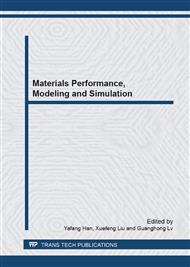p.473
p.479
p.484
p.491
p.498
p.504
p.510
p.518
p.528
Research on Flow Behavior of Advanced High Strength Steel at Elevated Temperature
Abstract:
Tensile experiments were carried out on advanced high strength steel (AHSS) by the test machine Gleeble3500, under the temperature ranging from 650 to 850 and the strain rate of 0.1/s~5/s, and the corresponding stress-strain curves were obtained. The peak stress level decreases with the increasing of deformation temperature or the decreasing of strain rate, which can be represented by a ZenerHollomon parameter in a linear equation. A revised model describing the relationships between the peak stress, strain rate and temperature of advanced high strength steel at elevated temperatures was proposed by compensation of strain and strain rate. The comparison of the predicted and experimental results of stressstrain curve can prove the good predictive power of the model, the Adj. R-Square between the peak stress and the linear equation was reached to 0.97.
Info:
Periodical:
Pages:
498-503
Citation:
Online since:
March 2013
Authors:
Price:
Сopyright:
© 2013 Trans Tech Publications Ltd. All Rights Reserved
Share:
Citation:


